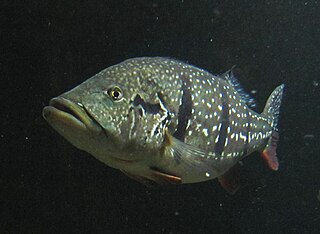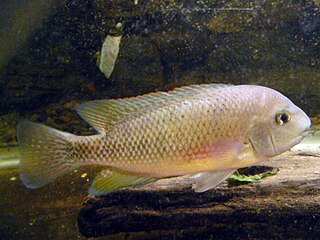
Cichlasoma is a genus of freshwater fish in the cichlid family. The genus was previously very large, including cichlids from North America, including Central America, and South America.

Crenicichla is a genus of cichlids native to South America commonly known as the pike cichlids. They are found in most tropical and subtropical freshwater habitats between the Andes and the Atlantic.

Aequidens is a genus of fish in the family Cichlidae found in South America. Formerly a wastebasket genus, as presently defined Aequidens is largely restricted to the Amazon Basin, Orinoco Basin and river basins in The Guianas. The only exceptions are A. plagiozonatus which also occurs in the Paraná Basin, and A. tetramerus which also occurs in the Parnaíba River.
Paraneetroplus is a genus of cichlid fish native to moderately to fast-flowing waters in the Coatzacoalcos, Grijalva and Papaloapan river basins in southern Mexico. They reach up to 20–25.5 cm (8–10 in) in length.
Theraps is a genus of cichlid fish that includes only a single species, the Arroya ciclid from fast-flowing rivers and streams in the Usumacinta and Polochic basins of southern Mexico and Guatemala. It is a medium-sized cichlid, up to 19 cm (7.5 in) in standard length.

Thorichthys is a genus of cichlid fish that is native to the Atlantic slope of Middle America, ranging from southern Veracruz and the Yucatán Peninsula in Mexico, to Guatemala and Honduras, with introduced populations in a few other countries. They tend to inhabit moderately-flowing to standing water such as rivers, streams, lakes, ditches and lagoons, and they are primarily freshwater fish, although T. helleri and T. meeki may occur in slightly brackish habitats.

Vieja is a genus of cichlid fish from Central America and Mexico. The majority of the species are freshwater fish found in stagnant or slow-moving waters of southern Mexico to El Salvador, but V. maculicauda, which also occurs in brackish waters, ranges south to Panama. They are high-bodied cichlids that reach lengths of up to 17–35 cm (7–14 in) depending on the exact species. Vieja feed mostly on vegetable matter, but may also take small invertebrates.

Archocentrus is a genus of cichlid fish from Central America. It currently contains a single species, the flier cichlid, which is found in stagnant and slow-moving freshwater habitats such as lakes, ponds, ditches, swamps and rivers in Honduras, Nicaragua and Costa Rica. It is up to 11 cm (4.3 in) long and feeds on invertebrates and detritus.

The Salvin's cichlid, also known as the yellow-belly cichlid or tricolored cichlid, is a species of the family Cichlidae. It is found in rivers of the Atlantic slope of southern Mexico, Belize, and Guatemala.

The Cichlinae are a subfamily of fishes in the cichlid family, native to Central and South America.

Heroini is a fish tribe from the Cichlasomatinae subfamily in the family Cichlidae (cichlids). All cichlids native to the Greater Antilles, United States, Mexico and northern Central America are members of this tribe. It also includes most cichlid species in southern Central America and several species from South America. A large percentage of its species were formerly placed in the genus Cichlasoma but have since been moved to other genera.

Maskaheros is a genus of cichlids fish found on Atlantic slope of southern Mexico and Guatemala in the Coatzacoalcos and Usumacinta River drainages. They are relatively large, high-bodied cichlids and were formerly included in the genus Paraneetroplus or Vieja.
Kihnichthys ufermanni, the Usumacinta cichlid, is a species of cichlid found in a few rivers in the Usumacinta River basin in Guatemala and southern Mexico. It typically occurs in rivers that are about 10–50 m (33–164 ft) wide, fairly deep, have few or no aquatic plants, and a variable water current. This species is the only known member of its genus, but several of its features, including the chisel-like teeth, are shared with Cincelichthys and whether they should be merged into a single genus is not yet fully resolved; a review in 2020 recommended that the Usumacinta cichlid should be moved into Cincelichthys. The Usumacinta cichlid reaches a standard length of 25 cm (10 in).

Cincelichthys is a genus of high-bodied cichlids found in southern Mexico to Guatemala, where they inhabit lakes, rivers and other freshwater habitats. They are large cichlids, up to 35–42.5 cm (14–17 in) long depending on species, with females reaching smaller sizes than males.
The Montecristo cichlid is a species of freshwater fish from the Atlantic slope of southern Mexico and Guatemala. This cichlid occurs in lagoons, creeks and rivers with slight to moderate current in the Grijalva–Usumacinta, Candelaria, Champotón and Coatzacoalcos river drainages. It is currently recognized as the only species in its genus, but it is closely related to –and possibly should be merged into– Vieja. The Montecristo cichlid reaches up to 24 cm (9.4 in) in standard length.
Chiapaheros grammodes is a species of cichlid fish found in the upper part of the Grijalva River basin in southern Mexico and far western Guatemala. Adults generally inhabit areas with moderate to strong current, but they can also be found in backwaters and juveniles generally occur in calm waters. This species is the only known member of its genus, but historically it has been placed in several other genera. It reaches up to about 20 cm (8 in) in standard length. C. grammodes is relatively aggressive and quite predatory, tending towards piscivory. Both natural and aquarium hybrids have occurred between this species and Vieja hartwegi.

Talamancaheros is a genus of cichlid fish found in fast- and moderately-flowing rivers on the Pacific slope of the Talamanca mountains of Costa Rica and western Panama. Talamancaheros reaches up to 25 cm (10 in) in standard length.

Cichlastomatini is a tribe of cichlids from South America, one of two tribes that make up the subfamily Cichlasomatinae. They were recognised in 1983 as an assemblage by the Swedish ichthyologist Sven O. Kullander by their four rather than five 5 dentary foramina in the lateralis canal system of the head, describing them as closely related to the genus Cichlasoma. Melanie Stiassny suggested that these fishes recognised as a clade by Kullander were divided into two groupings in 1991 which she termed cichlasomines and heroines, Kullander formally raised these to the tribes Cichlasomatini and Heroini of the subfamily Cichlasomatinae in 1999. In other classifications the tribe Cichlasomatini is placed in the subfamily Cichlinae.

Geophagini is a tribe of cichlids from the subfamily Cichlinae, the American cichlids. It is the sister taxon to the clade which includes the Cichlasomatini and Heroini. Fishes in the Geophagini are distributed from Panama south to Argentina, it is the most speciose of the seven tribes within the Cichlinae and it is subdivided into three sub-tribes, Acarichthyina, Crenicaratina, and Geophagina which together contain over 200 species. Geophagines show morphological and behavioural specialisations to enable them to sift the substrates within their mouths so that they can separate benthic invertebrates from substrates dominated by sand or silt.

Chuco is a genus of medium-sized cichlid fishes from moderately to fast-flowing rivers and streams on the Atlantic slope of southern Mexico and northern Central America.















